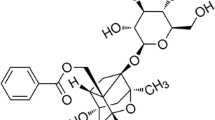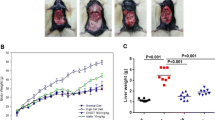Abstract
Objective
To investigate the mechanism of Panax notoginseng saponins (PNS), an effective component extracted from Panax notoginseng, on atherosclerotic plaque angiogenesis in atherosclerosis-prone apolipoprotein E-knockout (ApoE-KO) mice fed with high-fat, high-cholesterol diet.
Methods
Twenty ApoE-KO mice were divided into two groups, the model group and the PNS group. Ten normal C57BL/6J mice were used as a control group. PNS (60 mg/kg) was orally administered daily for 12 weeks in the PNS group. The ratio of plaque area to vessel area was examined by histological staining. The tissue sample of aortic root was used to detect the CD34 and vascular endothelial growth factor (VEGF) expression areas by immunohistochemistry. The expression of VEGF and nicotinamide adenine dinucleotide phosphate oxidase subunit 4 (NOX4) were measured by reverse transcription polymerase chain reaction and Western blotting respectively.
Results
After treatment with PNS, the plaque areas were decreased (P<0.05). CD34 expressing areas and VEGF expression areas in plaques were significantly decreased (P<0.05). Meanwhile, VEGF and NOX4 mRNA expression were decreased after treatment with PNS. VEGF and NOX4 protein expression were also decreased by about 72% and 63%, respectively (P<0.01).
Conclusion
PNS, which decreases VEGF and NOX4 expression, could alleviate plaque angiogenesis and attenuate atherosclerosis.
Similar content being viewed by others
References
Moulton KS, Heller E, Konerding MA, Flynn E, Palinski W, Folkman J. Angiogenesis inhibitors endostatin or TNP-470 reduce intimal neovascularization and plaque growth in apolipoprotein E-deficient mice. Circulation 1999;99:1726–1732.
Ferrara N, Davis-Smyth T. The biology of vascular endothelial growth factor. Endocr Rev 1997;18:4–25.
Celletti FL, Waugh JM, Amabile PG, Brendolan A, Hilfiker PR, Dake MD. Vascular endothelial growth factor enhances atherosclerotic plaque progression. Nat Med 2001;7:425–429.
Ushio-Fukai M, Alexander RW. Reactive oxygen species as mediators of angiogenesis signaling: role of NAD(P)H oxidase. Mol Cell Biochem 2004;264:85–97.
Abid MR, Kachra Z, Spokes KC, Aird WC. NADPH oxidase activity is required for endothelial cell proliferation and migration. FEBS Lett 2000;486:252–256.
Sorescu D, Weiss D, Lassegue B, Clempus RE, Szocs K, Sorescu GP, et al. Superoxide production and expression of nox family proteins in human atherosclerosis. Circulation 2002;105:1429–1435.
Datla SR, Peshavariya H, Dusting GJ, Mahadev K, Goldstein BJ, Jiang F. Important role of NOX4 type NADPH oxidase in angiogenic responses in human microvascular endothelial cells in vitro. Arterioscler Thromb Vasc Biol 2007;27:2319–2324.
Folkman J. Angiogenesis in cancer, vascular, rheumatoid and other disease. Nat Med 1995;1:27–31.
Moulton KS, Vakili K, Zurakowski D. Inhibition of plaque neovascularization reduces macrophage accumulation and progression of advanced atherosclerosis. Proc Natl Acad Sci U S A 2003;100:4736–4741.
Moulton KS. Plaque angiogenesis and atherosclerosis. Curr Atheroscler Rep 2001;3:225–233.
Di Stefano R, Felice F, Balbarini A. Angiogenesis as risk factor for plaque vulnerability. Curr Pharm Des 2009;15:1095–1106.
Liu Y, Chen KJ. Atherosclerosis, vascular aging and Ttherapeutic strategies. Chin J Integr Med 2012;18:83–87.
Fan JS, Liu DN, Huang G, Xu ZZ, Jia Y, Zhang HG, et al. Panax notoginseng saponins attenuate atherosclerosis via reciprocal regulation of lipid metabolism and inflammation by inducing liver x receptor alpha expression. J Ethnopharmacol 2012;142:732–738.
Tao LL, Lei Y, Wang GL, Zhu LQ, Wang Y. Effect of extracts from Radix Ginseng, Radix Notoginseng and Rhizoma Chuanxiong on delaying aging of vascular smooth muscle cells in aged rats. Chin J Integr Med 2012;18:582–590.
Dou L, Lu Y, Shen T, Huang X, Man Y, Wang S, et al. Panax notogingseng saponins suppress RAGE/MAPK signaling and NF-kappaB activation in apolipoprotein-Edeficient atherosclerosis-prone mice. Cell Physiol Biochem 2012;29:875–882.
Liu Y, Zhang HG, Jia Y, Li XH. Panax notoginseng saponins attenuate atherogenesis accelerated by zymosan in rabbits. Biol Pharm Bull 2010;33:1324–1330.
Liu G, Wang B, Zhang J, Jiang H, Liu F. Total Panax notoginsenosides prevent atherosclerosis in apolipoprotein E-knockout mice: Role of downregulation of CD40 and MMP-9 expression. J Ethnopharmacol 2009;126:350–354.
Zhang SH, Reddick RL, Piedrahita JA, Maeda N. Spontaneous hypercholesterolemia and arterial lesions in mice lacking apolipoprotein E. Science 1992;258:468–471.
Nakashima Y, Plump AS, Raines EW, Breslow JL, Ross R. ApoE-deficient mice develop lesions of all phases of atherosclerosis throughout the arterial tree. Arterioscler Thrombosis 1994;14:133–140.
Teo NB, Shoker BS, Martin L, Sloane JP, Holcombe C. Angiogenesis in pre-invasive cancers. Anticancer Res 2002;22:2061–2072.
Hannen EJ, Riediger D. The quantification of angiogenesis in relation to metastasis in oral cancer: a review. Int J Oral Maxillofac Surg 2004;33:2–7.
Krause DS, Fackler MJ, Civin CI, May WS. CD34: structure, biology, and clinical utility. Blood 1996;87:1–13.
Poncelet C, Madelenat P, Feldmann G, Walker F, Darai E. Expression of vonWillebrand’s factor, CD34, CD31, and vascular endothelial growth factor in uterine leiomyomas. Fertil Steril 2002;78:581–586.
Matsumoto T, Claesson-Welsh L. VEGF receptor signal transduction. Sci STKE 2001;2001:RE21.
Herrmann J, Lerman LO, Mukhopadhyay D, Napoli C, Lerman A. Angiogenesis in atherogenesis. Arterioscler Thromb Vasc Biol 2006;26:1948–1957.
Celletti FL, Hilfiker PR, Ghafouri P, Dake MD. Effect of human recombinant vascular endothelial growth factor165 on progression of atherosclerotic plaque. J Am Coll Cardiol 2001;37:2126–2130.
Ushio-Fukai M. Redox signaling in angiogenesis: role of NADPH oxidase. Cardiovasc Res 2006;71:226–235.
Nespereira B, Perez-Ilzarbe M, Fernandez P, Fuentes AM, Paramo JA, Rodriguez JA. Vitamins C and E downregulate vascular VEGF and VEGFR-2 expression in apolipoprotein-E-deficient mice. Atherosclerosis 2003;171:67–73.
Ushio-Fukai M, Urao N. Novel role of NADPH oxidase in angiogenesis and stem/progenitor cell function. Antioxid Redox Signal 2009;11:2517–2533.
Chen JX, Zeng H, Lawrence ML, Blackwell TS, Meyrick B. Angiopoietin-1-induced angiogenesis is modulated by endothelial NADPH oxidase. Am J Physiol Heart Circ Physiol 2006;291:H1563–H1572.
Ago T, Kitazono T, Ooboshi H, Iyama T, Han YH, Takada J, et al. NOX4 as the major catalytic component of an endothelial NAD(P)H oxidase. Circulation 2004;109:227–233.
Meng D, Mei A, Liu J, Kang X, Shi X, Qian R, et al. NADPH oxidase 4 mediates insulin-stimulated HIF-1α and VEGF expression, and angiogenesis in vitro. PLoS One 2012;7:e48393.
Zheng H, Liu C, Ou Y, Zhang Y, Fu X. Total saponins of Panax notoginseng enhance VEGF and relative receptors signals and promote angiogenesis derived from rat bone marrow mesenchymal stem cells. J Ethnopharmacol 2013;147:595–602.
Hong SJ, Wan JB, Zhang Y, Hu G, Lin HC, Seto SW, et al. Angiogenic effect of saponin extract from Panax notoginseng on HUVECs in vitro and zebrafish in vivo. Phytother Res 2009;23:677–686.
Author information
Authors and Affiliations
Corresponding author
Additional information
Supported by the Plans for the Development of Traditional Chinese Medicine Science and Technology of Shandong Province (No. 2011-203)
Rights and permissions
About this article
Cite this article
Qiao, Y., Zhang, Pj., Lu, Xt. et al. Panax notoginseng saponins inhibits atherosclerotic plaque angiogenesis by down-regulating vascular endothelial growth factor and nicotinamide adenine dinucleotide phosphate oxidase subunit 4 expression. Chin. J. Integr. Med. 21, 259–265 (2015). https://doi.org/10.1007/s11655-014-1832-4
Received:
Published:
Issue Date:
DOI: https://doi.org/10.1007/s11655-014-1832-4




